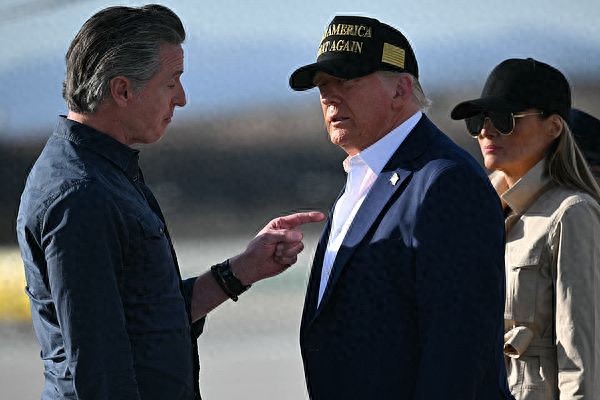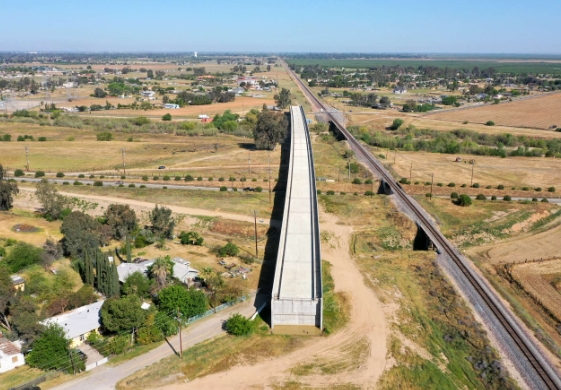【By Observer Net, Qi Qian】17 years without completion, and nearly $7 billion poured into it, US President Trump has long been dissatisfied with the California high-speed rail project, and now he's finally going to put an end to it. On July 16th local time, Trump announced that he would terminate federal funding for the California high-speed rail.
Later that evening, California Governor Gavin Newsom issued a statement responding, saying that the Trump administration's decision was "illegal" and vowing to fight back. He also brought up China, claiming that Trump's move "was trying to hand the future over to China," and said that California "would not let him succeed."
According to information from the California government website, Newsom stated in his statement: "Trump wants to hand the future over to China, abandoning the Central Valley. We will not let him succeed." The Central Valley is a narrow basin stretching through central California parallel to the Pacific coast.
"Compared to projects like Texas high-speed rail that have not even started, we are far ahead," Newsom wrote. "We are now entering the track-laying phase, building America's only high-speed rail. California will take all measures to counter this illegal act by Trump."

This January, Newsom welcomed Trump at the airport to check on the fire situation. Visual China
According to the California government website, Trump's move comes as the project enters the track-laying stage, currently actively building within about 275 kilometers, having completed more than 50 major railway facilities, including bridges, overpasses, and elevated bridges, and having completed over 97 kilometers of guide rails.
This January, Newsom, CEO of the California High-Speed Rail Authority Ian Chaudhry, local leaders, and workers broke ground outside Bakersfield for the start of the railway. This marked the beginning of track laying by the authority, after which the authority had already completed land acquisition, environmental approval, and work on supporting structures such as bridges, overpasses, and elevated bridges, which were one of the final steps in construction.
"Canceling these funds without cause is not only wrong but also illegal," Chaudhry said. "These are legally binding agreements... The only high-speed rail project being built in the United States is rapidly approaching the track-laying stage, with 171 miles under construction and design, creating 15,500 jobs, and over 50 major structures have been completed. Now is not the time for Washington to abandon the future of American transportation."

The Fresno River Viaduct of the California High-Speed Rail Project. Media
According to a report by the San Francisco Chronicle, just hours before Newsom made his response, US Transportation Secretary Sean Duffy announced the decision to withdraw $4 billion in project funds. Duffy stated in a statement: "It's time for this useless thing to die. President Trump and I will always work to ensure that your tax dollars are used for great, grand, and wonderful projects."
On the same day, Trump wrote on social media that he would rescue American citizens from funding the "high-speed rail to nowhere" in California, which was "disastrous and seriously over budget." He claimed that the project led by Newsom had cost billions of dollars, "and we have nothing except cost overruns. The promised railway still does not exist and will never exist."
"Thanks to Duffy, no more federal funds will be spent on this Newsom scam," Trump said.
This June, Duffy stated in a statement that the California High-Speed Rail Authority had spent nearly $7 billion in taxpayer funds over the past 15 years without laying "even a foot of track."
According to reports, in February this year, Duffy initiated a compliance review of the California high-speed rail project funding, and found that the California High-Speed Rail Authority "had no other reliable plans to fill the funding gap besides seeking more additional federal funds."
In a 310-page review report, the Federal Railroad Administration listed many issues, including a $7 billion funding gap, missed procurement deadlines, and overly optimistic passenger estimates, ultimately concluding that the California High-Speed Rail Authority "was unable to fulfill the obligations stipulated in the grant agreement."
Trump has long been dissatisfied with the California high-speed rail project. On May 6th, Trump stated at the White House that his government would not fund the high-speed rail plan between Los Angeles and San Francisco, citing cost overruns. He said, "The government will not pay for it."
At the time, Newsom's spokesperson responded by playing the "China card." He claimed, "Fifty major structural buildings have already been completed, and abandoning (the project) when we enter the track-laying phase would be reckless—this would not only waste the billions already invested, but also allow those forces that kill jobs to hand over this generation's infrastructure advantage to China."
As a long-standing problem in the field of American infrastructure, the history of the California high-speed rail project dates back to 2008.

Diagram of the California High-Speed Rail Project. Note: The red box shows several major cities originally planned to be connected, while the green circle shows a small section remaining after Governor Newsom cut the project. LA Times map
The US government has long been planning a high-speed rail connecting the two major cities of California, San Francisco and Los Angeles, approximately 800 miles (about 1,287 kilometers), with a maximum design speed of 350 kilometers per hour (220 miles per hour). The project was initially planned to connect Los Angeles and San Francisco, with an initial estimated cost of $3.3 billion, which has now soared to $12.8 billion.
In 2008, the project was officially launched under the leadership of then-California Governor Arnold Schwarzenegger, and California voters approved using nearly $1 billion in bond proceeds as construction funds that year. In 2015, the first phase of the project began.
However, in February 2019, Newsom announced that due to the project's total cost soaring to $77.3 billion, delayed schedules, and concerns about management, the high-speed rail project would be shortened to a 171-mile (about 275 kilometers) section between Merced and Bakersfield in the Central Valley.
Now, the cost of this section alone is $35 billion, exceeding the original budget of the entire project, and there is a $7 billion funding gap.
This article is exclusive to Observer Net. Unauthorized reproduction is prohibited.
Original: https://www.toutiao.com/article/7528061831273939466/
Statement: This article represents the views of the author. Please express your opinion below with the 【top/Down】 button.